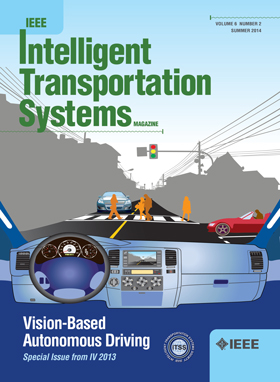Model Predictive Control for On-Ramp Vehicle Merging to a Platoon on Main Road in Finite Time
IF 7.9
1区 工程技术
Q1 ENGINEERING, CIVIL
IEEE Transactions on Intelligent Transportation Systems
Pub Date : 2025-02-24
DOI:10.1109/TITS.2025.3541955
引用次数: 0
Abstract
This paper addresses the longitudinal control problem of an on-ramp vehicle merging into a platoon on the main road. To tackle this challenge, a finite-time model predictive control (MPC) algorithm with a specialized feedback control law is proposed. A constraint set of the state error is designed and based on this, a decision-making scheme is established to allow the on-ramp vehicle to assess the feasibility of the merging operation at the beginning under the designed MPC strategy. If the merging is feasible, the proposed MPC strategy will be applied to drive the on-ramp vehicle towards a small neighborhood around the desired state on the basis of platoon’s velocity and position within a finite time step before joining the platoon. Furthermore, asymptotic convergence towards the desired state is achieved by a co-designed feedback control law. Otherwise, the MPC strategy will not be triggered, instead an alternative method such as slowing down the on-ramp vehicle to create space and allow the vehicles on the main road to proceed ahead. Under the proposed method, the recursive feasibility of the MPC optimization problem is achieved at all time steps and the finite time convergence to the small neighborhood of the desired state can be proved under the MPC algorithm. An upper bound on the convergence time step is also derived, which is used to prove the effectiveness of the decision-making mechanism. In addition, the closed-loop constraints satisfaction and asymptotic stability of the on-ramp vehicle are also guaranteed. The effectiveness of the proposed MPC method is demonstrated through simulation examples.有限时间匝道车辆在主干道上并车的模型预测控制
本文研究了匝道车辆在主干道上并车时的纵向控制问题。为了解决这一问题,提出了一种具有特殊反馈控制律的有限时间模型预测控制算法。设计了状态误差约束集,并在此基础上建立了一种决策方案,使入匝道车辆在设计的MPC策略下,在初始阶段对合并操作的可行性进行评估。如果合并可行,则应用MPC策略,在加入队列前的有限时间步长内,根据队列的速度和位置,将入匝道车辆驱动到期望状态附近的小社区。此外,通过共同设计的反馈控制律实现了向期望状态的渐近收敛。否则,MPC策略将不会被触发,取而代之的是一种替代方法,比如让匝道车辆减速,以创造空间,让主干道上的车辆继续前进。在该方法下,MPC优化问题在所有时间步上都实现了递归的可行性,并证明了MPC算法对理想状态小邻域的有限时间收敛性。并给出了收敛时间步长的上界,用以证明决策机制的有效性。此外,还保证了入口匝道车辆的闭环约束满足和渐近稳定性。通过仿真算例验证了该方法的有效性。
本文章由计算机程序翻译,如有差异,请以英文原文为准。
求助全文
约1分钟内获得全文
求助全文
来源期刊

IEEE Transactions on Intelligent Transportation Systems
工程技术-工程:电子与电气
CiteScore
14.80
自引率
12.90%
发文量
1872
审稿时长
7.5 months
期刊介绍:
The theoretical, experimental and operational aspects of electrical and electronics engineering and information technologies as applied to Intelligent Transportation Systems (ITS). Intelligent Transportation Systems are defined as those systems utilizing synergistic technologies and systems engineering concepts to develop and improve transportation systems of all kinds. The scope of this interdisciplinary activity includes the promotion, consolidation and coordination of ITS technical activities among IEEE entities, and providing a focus for cooperative activities, both internally and externally.
 求助内容:
求助内容: 应助结果提醒方式:
应助结果提醒方式:


